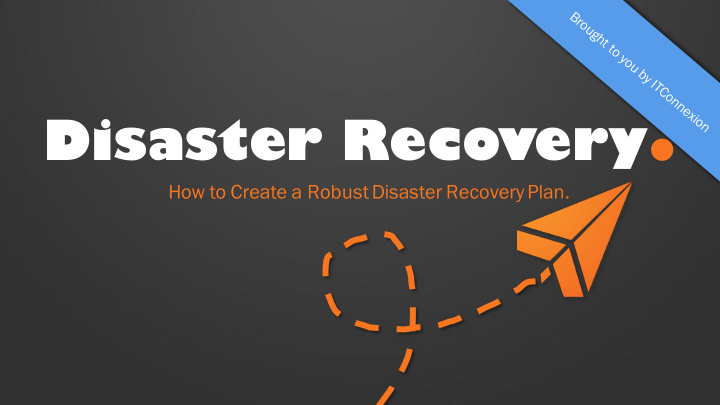



Disaster Recovery . How to Create a Robust Disaster Recovery Plan.
Today’s agenda The drivers behind a DR Plan Disaster Recovery Fundamentals Risk analysis for Small Business & NFP Steps to build a robust DR Plan How cloud computing can help What’s Next?
“Let’s get to know you. Please help me by answering a few questions…” Dr. Carlson Ho Director of ITConnexion
Source: : Company y Name
Main n drivers rs of a DR Plan 1 Prevent loss of Data (Protection of intellectual property) 2 Restore your system in a timely fashion (Business continuity) 3 Compliance (e.g. board compliance, tender processes & government requirements)
DR Fundam ndament ntal als Recovery Time Objective (RTO) and 1 Recovery Point Objective (RPO) 2 Recovery Classes 3 7 tiers of Disaster Recovery
Ke Key Measu sures s - Time and Data! Recovery Point Object ctive Recovery Time Object ctive (RPO) (RTO) o o o o o o o o o o o o 4am 6am 7am 8am 9am 11am 12pm 1pm 2pm 3pm 4pm 5am 10 am How much data can you How much time your Disaster Strikes afford to lose? business can survive?
Where is your business situa tuated ted? Recovery y Time Objective (RTO) ) and d Recovery y Point nt Objective (RPO) Class 1 Class 2 Class 3 Class 4 72 hours to 8 hours to Less than 8 RTO 0 minutes 1 Week 72 hours hours Last backup - Less than 15 Last full backup - RPO less than 24 minutes before 0 minutes Less than 1 week hours the event (https://en.wikipedia.org/wiki/Seven_tiers_of_disaster_recovery)
7 tiers rs of Disas aster r Recover very • No off-site data – Possibly no recovery 0 • Data Backup with no hot site Tier 1 • Data backup with a hot site Tier 2 • Electronic vaulting Tier 3 • Point-in-time copies Tier 4 • Transaction integrity Tier 5 • Zero or near-zero data loss Tier 6 • Highly automated, business integrated solution Tier 7 Source: https://en.wikipedia.org/wiki/Seven_tiers_of_disaster_recovery
Recovery Time me versus us Cost • Tier 7 Astronomi mical • Very High Tier 6 ost on Cos High Tier 5 • Mitigation Medium Tier 4 • Medium m Low Tier 3 • Tier 2 Low • Tier 1 • Very Low Seconds Minutes Hours Days Weeks Recov overy Time me Source: https://en.wikipedia.org/wiki/Seven_tiers_of_disaster_recovery
Developing ng the plan. n. Key Steps. Risk & Impact Assessment 1 Develop the Execution Plans 2 - Action Plan - Communication Plan - Detail Recovery Plan 3 Test 4 Post Actions
Risk & Imp mpact t Assessme ment nt Identify most important business functions => Pinpoint the IT a system and assets that support these functions. b Examine threats and vulnerabilities (internal & external) that will severely impact the company’s ability to conduct business: Loss of data (e.g.. Server failure, accidental or deliberate deletion) Loss of IT function (e.g.. Computer virus, vendor out of business) Loss of skills (e.g.. accidents, illness) Loss of access (e.g.. Fire, flood, extended power outage) c Determine the risk factor by assessing: Likelihood of occurrence Impact to business
Risk Facto tor Matrix High Impact to Organisation Eg. build Eg. Have a some plan B redundancy Plan Prevent Impact Likelihood Low Risk High Risk (Likely) (Unlikely) Contain Accept Eg. Eg. education communicate & incremental situation with improvement Low Impact to Organisation stakeholders
Developing ng the Executi ution n Plans ns 1 Define ne your ur action n plan • Minimum number of core staff to conduct business • Minimum technology to conduct business Determine priority of recovery • 2 Communication on Plan • Who is in charge of communication How to reach your staff, customers and suppliers and inform • them of the situation (you may have no access to emails and contact lists)
Developing your DR plan cont’d 3 Detail Recovery y Plans ns • System specification • Warranty & vendor support information • Support contact information Dependencies (hardware, software, licenses, • backup) • Recovery Procedure – the steps and estimated time to perform the recovery.
After the Plan ans 1 Identify components where you may do a test-run. 2 Identify the gap for input into the next IT Strategy Plan 3 Store your DR plans offsite
Sett tting ng a DR plan n on a budge get 1 Be realistic, start with a simple plan and build on it over time. 2 Focus on the most critical components in your business 3 Think outside the box
Can cloud ud comp mputi uting ng help? 1 Data Centers are equipped with redundancies (power, hard disks, servers, internet links) and offer ideal operating environment for computing devices (dust free, constant temperature and humidity) 2 Simplify your infrastructure and therefore inherently reduce your overall risk. 3 Choose reputable cloud solution providers.
To summa mmarise …… 1 Recovery Point Objective (data) and Recovery Time Objective (time) 2 Risk & Impact Assessment – assess likelihood and impact of risks 3 Execution plans – action plan, communication plan and detail recovery plan 4 Identify gaps for consideration in your next IT plan 5 You can develop your DR plan on a limited budget & resource 6 Consider cloud technology as part of your DR solution
Contact me on 1300 89 22 00 Or Email carlson@itconnexion.com http://www.itconnexion.com/
… AND WE’RE DONE! Any questions?
Recommend
More recommend